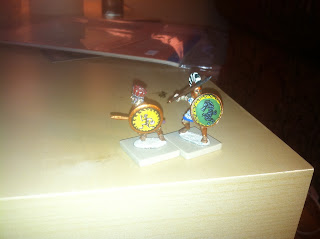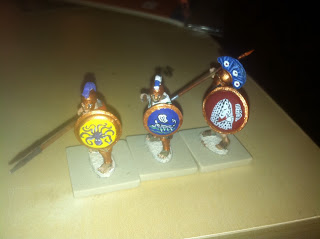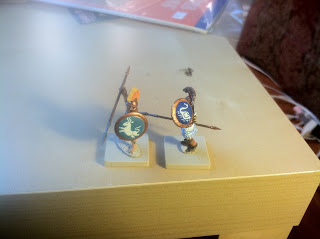While painting my hippeis, I got a bug up my ass, and the bug was this: why are all my horses "four on the floor"? A horse rearing up is such a dramatic pose that it astounds me to see very few 28mm horse miniatures up on their hind legs. My need for a rearing horseman ticked in my brain like the tell-tale heart; I would go mad if I did not get one, so I ordered a pair from England. Along with them I got some greenstuff. I used a tiny amount of greenstuff to make this saddle and bridle, as this horse had been naked.

I didn't find it too hard to work with. A 50-50 blend of the two greenstuff components gave me a slightly stiff clay and I have some clay experience. For the saddle blanket, I just mashed some greenstuff on its back and cut it into a more or less square shape. The reins were just some very thin snakes, you know snakes, the first thing everybody learns how to make with clay.
I decided immediately that I ought to try something a little more complex and so I went further: I sculpted replacements for my two phalaxes' battle standards, a golden fleece (for which i needed to sculpt a ram's head) and a gorgon's head. I also tried a lyre; I'd love to have a lyre player for a unit musician. In my opinion, the lyre and the goat's head came out a little on the clunky side but they demonstrated that, with a little practice, the kind of sculpting i want to do, I can do. The medusa's head is really good and I might well mount that sucker on a metal standard, consider replacing my old sculpey and pipe cleaner gorgon's head standard. That debate will be the subject of a future post.
Here's that rearing horse with his greenstuff saddle. I decorated his base before painting the figure which was kind of backwards for me but didn't cause any serious problems.
And now the whole cavalry unit with Rearing Guy front and center. I've decided he'll count as the unit leader if i use these fellas in a wargame
Dramatic angle.
This picture shows the proper use of Hellenic cavalry: smashing apart a gang of peltasts. The wedge formation that a lot of wargamers do with their cavalry was called the "Flying Theban Wedge" in Greece.
Smashy, smashy


































